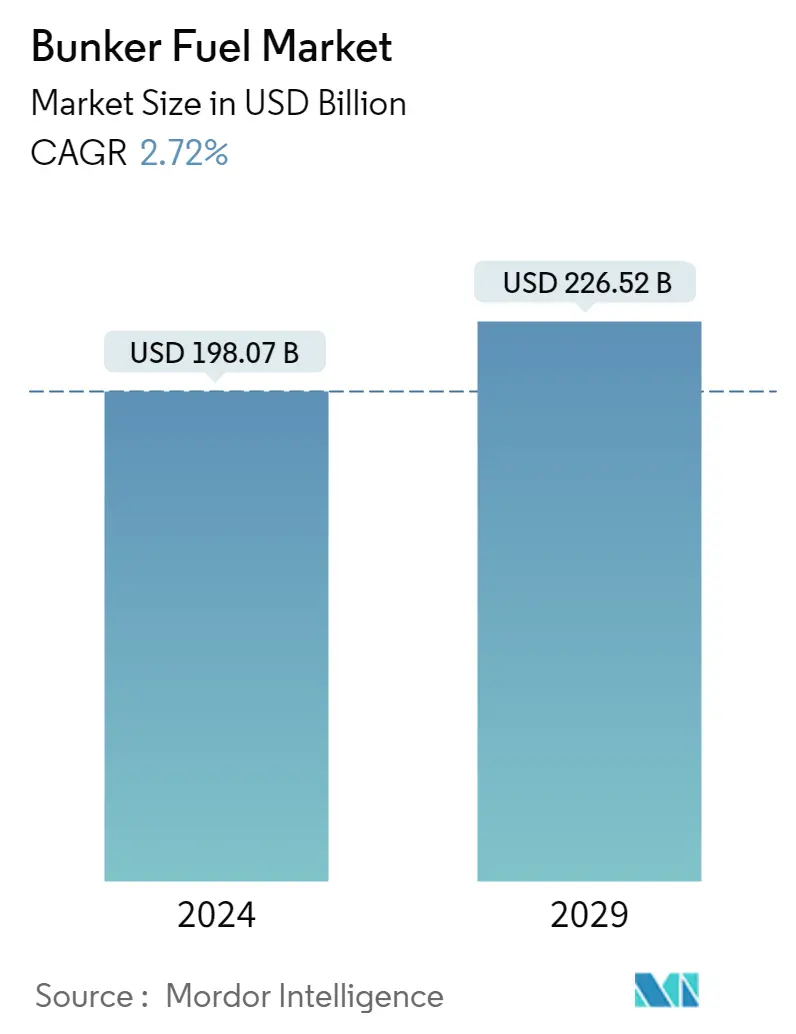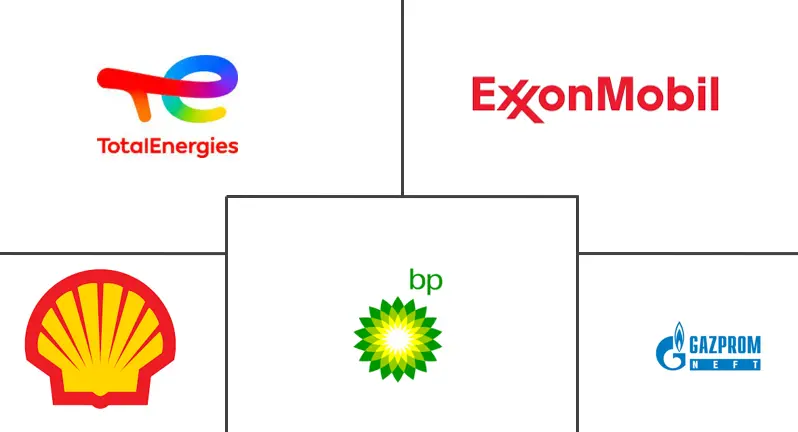Market Size of Bunker Fuel Industry

| Study Period | 2020 - 2029 |
| Market Size (2024) | USD 198.07 Billion |
| Market Size (2029) | USD 226.52 Billion |
| CAGR (2024 - 2029) | 2.72 % |
| Fastest Growing Market | Asia Pacific |
| Largest Market | Asia Pacific |
Major Players
*Disclaimer: Major Players sorted in no particular order |
Bunker Fuel Market Analysis
The Bunker Fuel Market size is estimated at USD 198.07 billion in 2024, and is expected to reach USD 226.52 billion by 2029, growing at a CAGR of 2.72% during the forecast period (2024-2029).
The market was negatively impacted by COVID-19 in 2020. Presently the market has now reached pre-pandemic levels.
- Over the medium term, Increasing LNG trade is expected to increase the demand for bunker fuel. LNG is majorly traded for the power sector in industrial, commercial and residential segments. The countries with high coal dependencies, such as China and India, are gradually moving toward cleaner energy by increasing the import volume of natural gas from the Middle-east nations and few other nations, like the Russian Federation, Australia, Nigeria.
- On the other hand, the environmental concerns and the strict regulations related to emissions from maritime industry are anticipated to limit the usage of the heavy bunker fuels, especially the high Sulfur fuel oil, during the forecast period.
- Nevertheless, with the improved economic performance of developing countries in regions, such as the Asia-Pacific and the Middle-East and Africa, the demand for marine transportation and the number of ships in operation are expected to increase, offering significant growth opportunity for the bunker fuel market players in the coming years.
- Asia-Pacific is expected to dominate the market during the forecast period, with the majority of the demand coming from countries like China, India, etc.
Bunker Fuel Industry Segmentation
Bunker fuel is the general term given to any fuel poured into a ship's bunkers to power its engines. Deep-sea cargo ships typically burn the heavy, residual oil left over after gasoline, diesel, and other light hydrocarbons that are extracted from crude oil during the refining process. The bunker fuel market is segmented by fuel type, vessel type, and geography. By fuel type, the market is segmented into high sulfur fuel oil (HSFO), very low sulfur fuel oil (VLSFO), marine gas oil (MGO), liquefied natural gas (LNG), and other fuel types. By vessel type, the market is segmented into containers, tankers, general cargo, bulk carriers, and other vessel types. The report also covers the market size and forecasts for the Bunker Fuel market across major regions. For each segment, the market sizing and forecasts have been done based on revenue (USD billion).
| Fuel Type | |
| High Sulfur Fuel Oil (HSFO) | |
| Very Low Sulfur Fuel Oil (VLSFO) | |
| Marine Gas Oil (MGO) | |
| Liquefied Natural Gas (LNG) | |
| Other Fuel Types |
| Vessel Type | |
| Containers | |
| Tankers | |
| General Cargo | |
| Bulk Carriers | |
| Other Vessel Types |
| Geography | |||||||
| |||||||
| |||||||
| |||||||
| |||||||
|
Bunker Fuel Market Size Summary
The bunker fuel market is poised for steady growth over the forecast period, driven by the increasing demand for marine transportation and the expansion of LNG trade. The market has rebounded to pre-pandemic levels, with Asia-Pacific expected to dominate due to the significant maritime trade activities in countries like China and India. The shift towards cleaner energy sources, particularly the import of natural gas, is influencing the demand for bunker fuel, despite environmental concerns and stringent emission regulations that may limit the use of heavy bunker fuels. The economic growth in developing regions, coupled with the rise in the number of operational ships, presents substantial opportunities for market players.
The LNG bunkering sector has seen significant advancements, with investments in infrastructure and the growing adoption of LNG-powered vessels. Although the conversion of existing vessels to LNG is costly, the operational efficiency and reduced carbon footprint make it an attractive long-term option. The demand for low sulfur fuel oil has increased due to regulatory restrictions, and LNG is gaining traction as a viable alternative to conventional oil-based fuels. The market remains fragmented, with major players like ExxonMobil, Shell, and TotalEnergies actively participating. Strategic partnerships and investments in LNG infrastructure, such as those by Titan LNG and Nimofast BrasilS.A, are enhancing the availability and adoption of LNG in various regions, particularly in Europe and Brazil.
Bunker Fuel Market Size - Table of Contents
-
1. MARKET OVERVIEW
-
1.1 Introduction
-
1.2 Market Size and Demand Forecast in USD billion, till 2028
-
1.3 Recent Trends and Developments
-
1.4 Government Policies and Regulations
-
1.5 Market Dynamics
-
1.5.1 Drivers
-
1.5.1.1 Increased LNG Trade Worldwide
-
1.5.1.2 Increasing Dependecies over Natural Gas for Power Generation
-
-
1.5.2 Restraints
-
1.5.2.1 Environmental Concerns and the Strict Regulations Related to Emissions from Maritime Industry
-
-
-
1.6 Supply Chain Analysis
-
1.7 Porter's Five Forces Analysis
-
1.7.1 Bargaining Power of Suppliers
-
1.7.2 Bargaining Power of Consumers
-
1.7.3 Threat of New Entrants
-
1.7.4 Threat of Substitute Products and Services
-
1.7.5 Intensity of Competitive Rivalry
-
-
-
2. MARKET SEGMENTATION
-
2.1 Fuel Type
-
2.1.1 High Sulfur Fuel Oil (HSFO)
-
2.1.2 Very Low Sulfur Fuel Oil (VLSFO)
-
2.1.3 Marine Gas Oil (MGO)
-
2.1.4 Liquefied Natural Gas (LNG)
-
2.1.5 Other Fuel Types
-
-
2.2 Vessel Type
-
2.2.1 Containers
-
2.2.2 Tankers
-
2.2.3 General Cargo
-
2.2.4 Bulk Carriers
-
2.2.5 Other Vessel Types
-
-
2.3 Geography
-
2.3.1 North America
-
2.3.1.1 United States
-
2.3.1.2 Canada
-
2.3.1.3 Rest of North America
-
-
2.3.2 Europe
-
2.3.2.1 Germany
-
2.3.2.2 France
-
2.3.2.3 United Kingdom
-
2.3.2.4 Rest of Europe
-
-
2.3.3 Asia-Pacific
-
2.3.3.1 China
-
2.3.3.2 India
-
2.3.3.3 Japan
-
2.3.3.4 South Korea
-
2.3.3.5 Rest of Asia-Pacific
-
-
2.3.4 South America
-
2.3.4.1 Brazil
-
2.3.4.2 Argentina
-
2.3.4.3 Rest of South America
-
-
2.3.5 Middle-East and Africa
-
2.3.5.1 Saudi Arabia
-
2.3.5.2 United Arab Emirates
-
2.3.5.3 South Africa
-
2.3.5.4 Rest of Middle-East and Africa
-
-
-
Bunker Fuel Market Size FAQs
How big is the Bunker Fuel Market?
The Bunker Fuel Market size is expected to reach USD 198.07 billion in 2024 and grow at a CAGR of 2.72% to reach USD 226.52 billion by 2029.
What is the current Bunker Fuel Market size?
In 2024, the Bunker Fuel Market size is expected to reach USD 198.07 billion.

